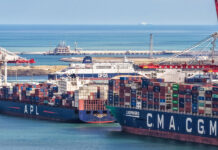
In the first plenary session of the European Parliament (EP) in March members of the European Parliament (MEP’s) debated the introduction of a carbon levy on European Union (EU) imports as a method of curbing the use of fossil fuels and reducing the bloc’s carbon footprint, which could have a profound effect on supply chains.
[s2If is_user_logged_in()]In the latest move to meet its Paris Agreement obligations, the EU is discussing proposals to introduce a carbon border adjustment mechanism (CBAM) on all imports covered by the EU Emissions Trading System (EU ETS).
While the CBAM measures do not mention transportation per se, the effects on the cost of imported goods could substantially alter the demand for merchandise that is produced outside the EU. The measure effectively seeks to calculate and price the carbon emissions for manufacturing and delivering goods into the EU, which will necessarily increase the cost of imported merchandise.
European politicians believe that the global debate on climate change has shifted enormously over the past year and that the timing for the development of new measures, to be implemented in 2023, to curb climate change is right.
Paolo Gentiloni, European commissioner for economy, speaking yesterday at the EP, said that climate change issues were “now on the global agenda. A year ago it was completely unthinkable to have some great power, a main trading power, discussing a CBAM or a carbon tax.”
Voting is expected to take place on the evening of 10 March, on a motion that requires the new CBAM regulation to be compatible with World Trade Organization (WTO) rules and to meet any obligations the EU has under existing free trade agreements (FTAs).
In effect, the CBAM regulation must not be discriminatory or constitute a disguised restriction on international trade, but CBAM should “create an incentive for European industries and EU trade partners to decarbonise their industries and therefore support both EU and global climate policies towards GHG neutrality in line with the Paris Agreement objectives,” according to the motion under debate.
Furthermore, the motion categorically states that CBAM should be designed to advance climate objectives and should “not be misused as a tool to enhance protectionism, unjustifiable discrimination or restrictions,” while also seeking to create a global market that is fair for all players.
Effectively the motion is aimed at encouraging the development of measures that will bring about a rapid reduction in greenhouse gas emissions that is derived from EU production and consumption.
But the backers of the motion stress that CBAM must be a part of a broader range of policy measures aimed at “promoting investments in low-carbon industrial processes, including through innovative financing tools, the new Circular Economy Action Plan and a broader EU industrial policy.”
Moreover, the EU must prevent distortions to the internal market and along the supply chain as a result of CBAM.
CBAM will cover, the power sector and “energy-intensive industrial sectors like cement, steel, aluminium, oil refining, paper, glass, chemicals and fertilisers, which continue to receive substantial free allocations, and still represent 94% of EU industrial emissions.”
According to the motion the GHG emissions content of imports should be calculated through “transparent, reliable and up-to-date product-specific benchmarks at the level of the installations in third countries and that, as a default, if data is not made available by the importer, account should be taken of the global average GHG emissions content of individual products.”
Furthermore, the EP must consider the difficulties around the problem of “carbon leakage,” where manufacturing moves outside of the EU to get around carbon levy regulations.
This will require the CBAM charges to “mirror the carbon costs paid by EU producers,” and “the dynamic evolution of the price of EU allowances under the EU ETS while ensuring predictability and less volatility in the price of carbon.”
[/s2If]
[s2If !is_user_logged_in()]Please login or register to read the rest of the story[/s2If]





